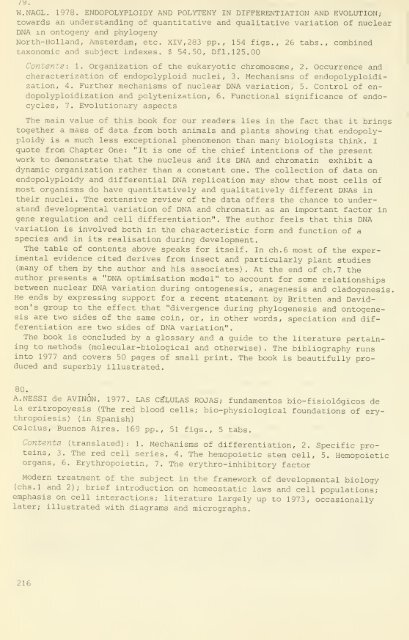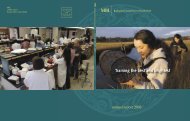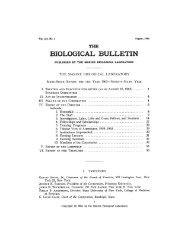General embryological information service - HPS Repository
General embryological information service - HPS Repository
General embryological information service - HPS Repository
You also want an ePaper? Increase the reach of your titles
YUMPU automatically turns print PDFs into web optimized ePapers that Google loves.
y.<br />
W.NAGL. 1978. ENDOPOLYPLOIDY AND POLYTENY IN DIFFERENTIATION AND EVOLUTION;<br />
towards an understanding of quantitative and qualitative variation of nuclear<br />
DNA in ontogeny and phylogeny<br />
North-Holland, Amsterdam, etc. XIV, 283 pp., 154 figs., 26 tabs., combined<br />
taxonomic and subject indexes. $ 54.50, Df1.125.00<br />
Contents: 1. Organization of the eukaryotic chromosome, 2. Occurrence and<br />
characterization of endopolyploid nuclei, 3. Mechanisms of endopolyploidization,<br />
4. Further mechanisms of nuclear DNA variation, 5, Control of endopolyploidization<br />
and polytenization, 6. Functional significance of endocycles,<br />
7. Evolutionary aspects<br />
The main value of this book for our readers lies in the fact that it brings<br />
together a mass of data from both animals and plants showing that endopolyploidy<br />
is a much less exceptional phenomenon than many biologists think. I<br />
quote from Chapter One: "It is one of the chief intentions of the present<br />
work to demonstrate that the nucleus and its DNA and chromatin exhibit a<br />
dynamic organization rather than a constant one. The collection of data on<br />
endopolyploidy and differential DNA replication may show that most cells of<br />
most organisms do have quantitatively and qualitatively different DNAs in<br />
their nuclei. The extensive review of the data offers the chance to understand<br />
developmental variation of DNA and chromatin as an important factor in<br />
gene regulation and cell differentiation". The author feels that this DNA<br />
variation is involved both in the characteristic form and function of a<br />
species and in its realisation during development.<br />
The table of contents above speaks for itself. In ch.6 most of the experimental<br />
evidence cited derives from insect and particularly plant studies<br />
(many of them by the author and his associates). At the end of ch.7 the<br />
author presents a "DNA optimisation model" to account for some relationships<br />
between nuclear DNA variation during ontogenesis, anagenesis and cladogenesis<br />
He ends by expressing support for a recent statement by Britten and Davidson's<br />
group to the effect that "divergence during phylogenesis and ontogenesis<br />
are two sides of the same coin, or, in other words, speciation and differentiation<br />
are two sides of DNA variation".<br />
The book is concluded by a glossary and a guide to the literature pertaining<br />
to methods (molecular-biological and otherwise) . The bibliography runs<br />
into 1977 and covers 50 pages of small print. The book is beautifully produced<br />
and superbly illustrated.<br />
A.NESSI de AVINON. 1977. LAS CE!luLAS ROJAS; fundamentos bio-f isiologicos de<br />
la eritropoyesis (The red blood cells; bio-physiological foundations of erythropoiesis)<br />
(in Spanish)<br />
Celcius, Buenos Aires. 169 pp., 51 figs., 5 tabs.<br />
Contents (translated): 1. Mechanisms of differentiation, 2. Specific proteins,<br />
3. The red cell series, 4. The hemopoietic stem cell, 5. Hemopoietic<br />
organs, 6. Erythropoietin, 7. The ery thro-inhibitory factor<br />
Modern treatment of the subject in the framework of developmental biology<br />
(chs.l and 2); brief introduction on homeostatic laws and cell populations;<br />
emphasis on cell interactions; literature largely up to 1973, occasionally<br />
later; illustrated with diagrams and micrographs.<br />
216<br />
.
















